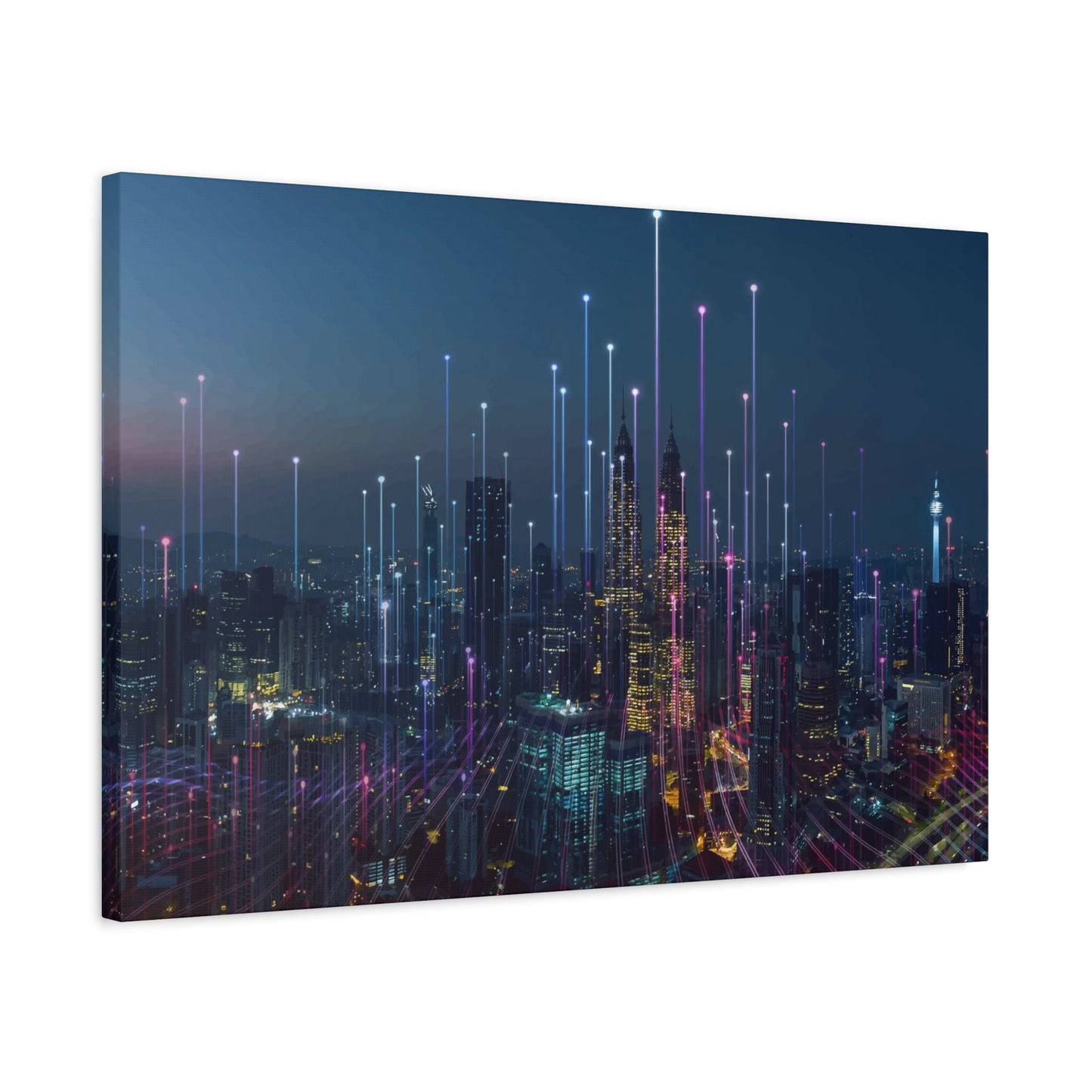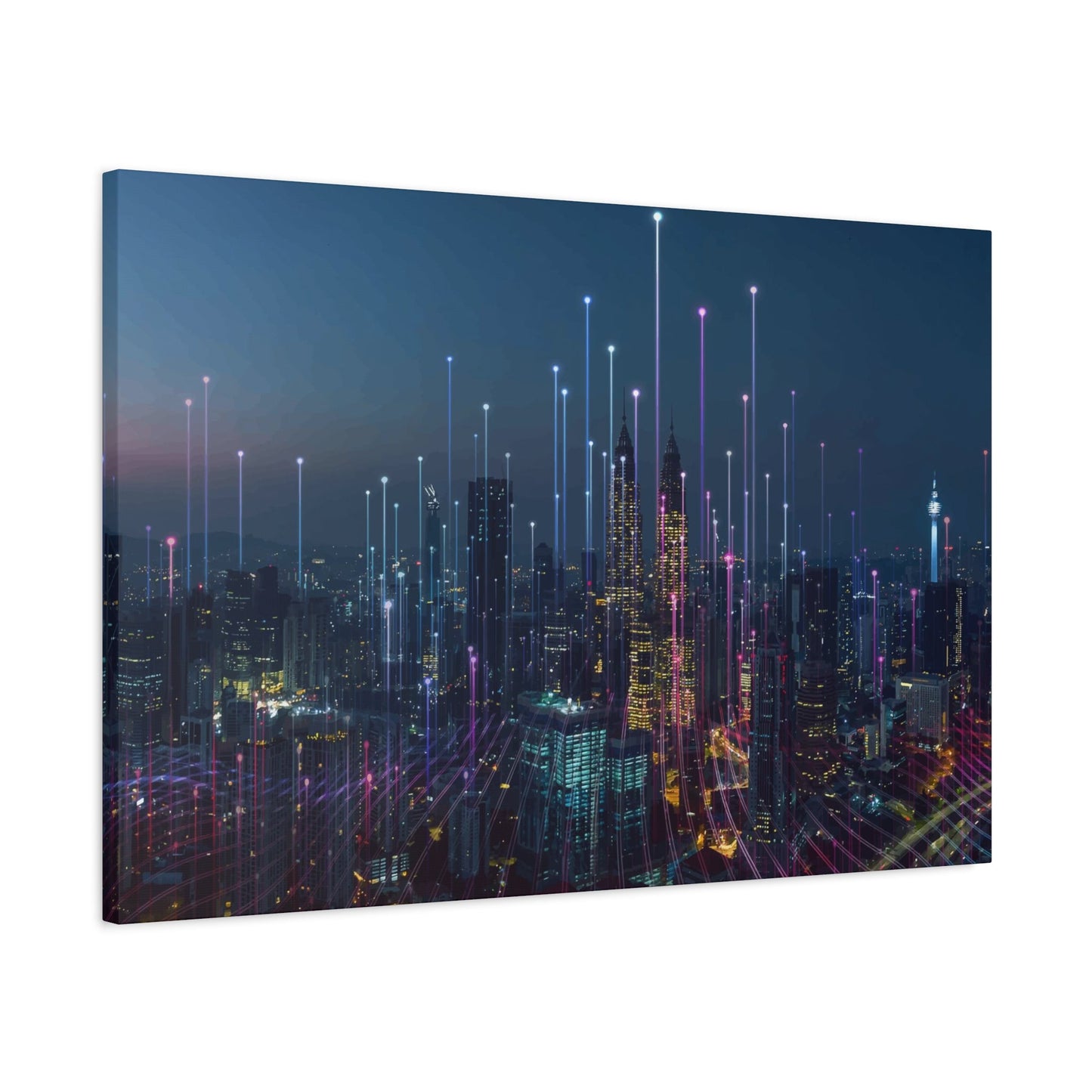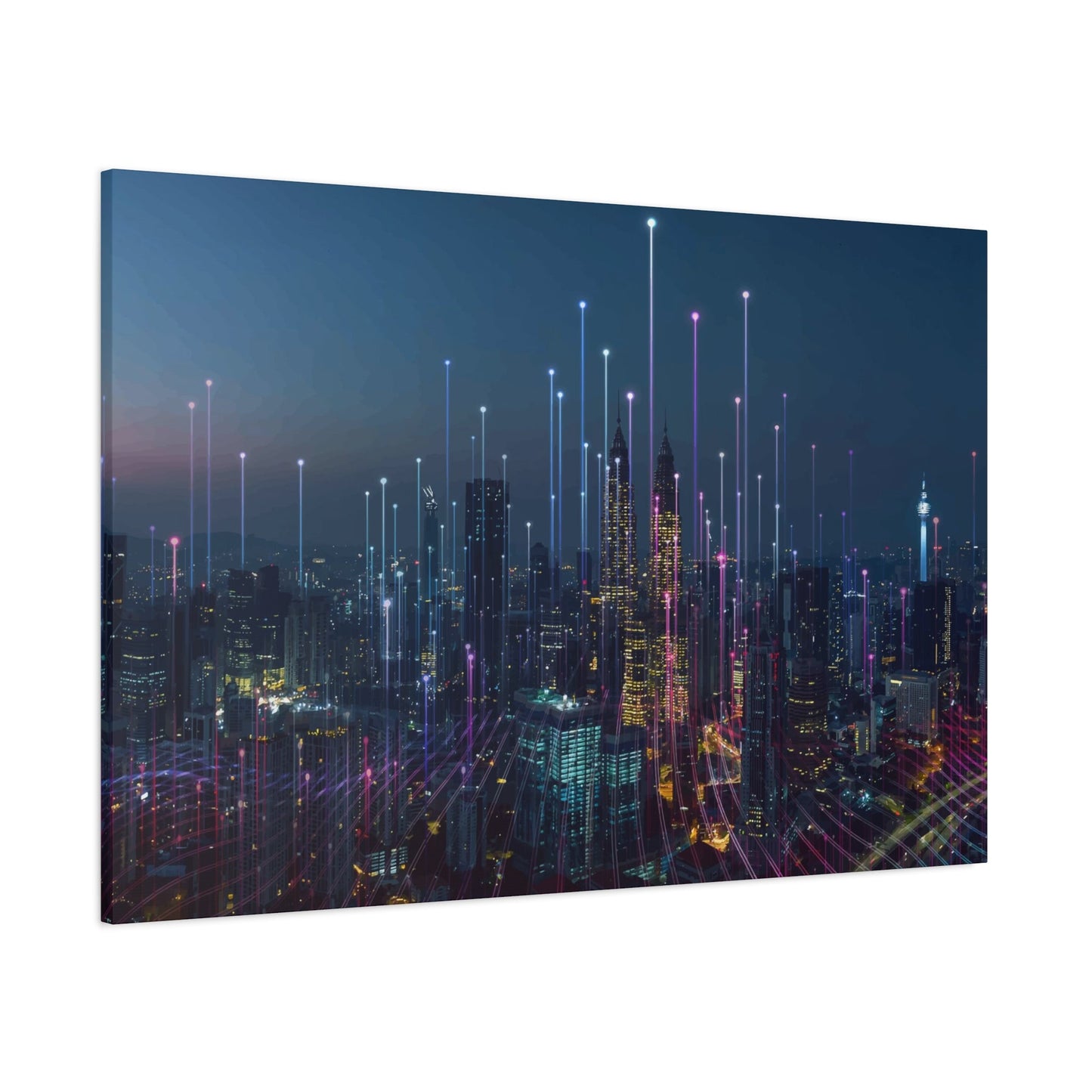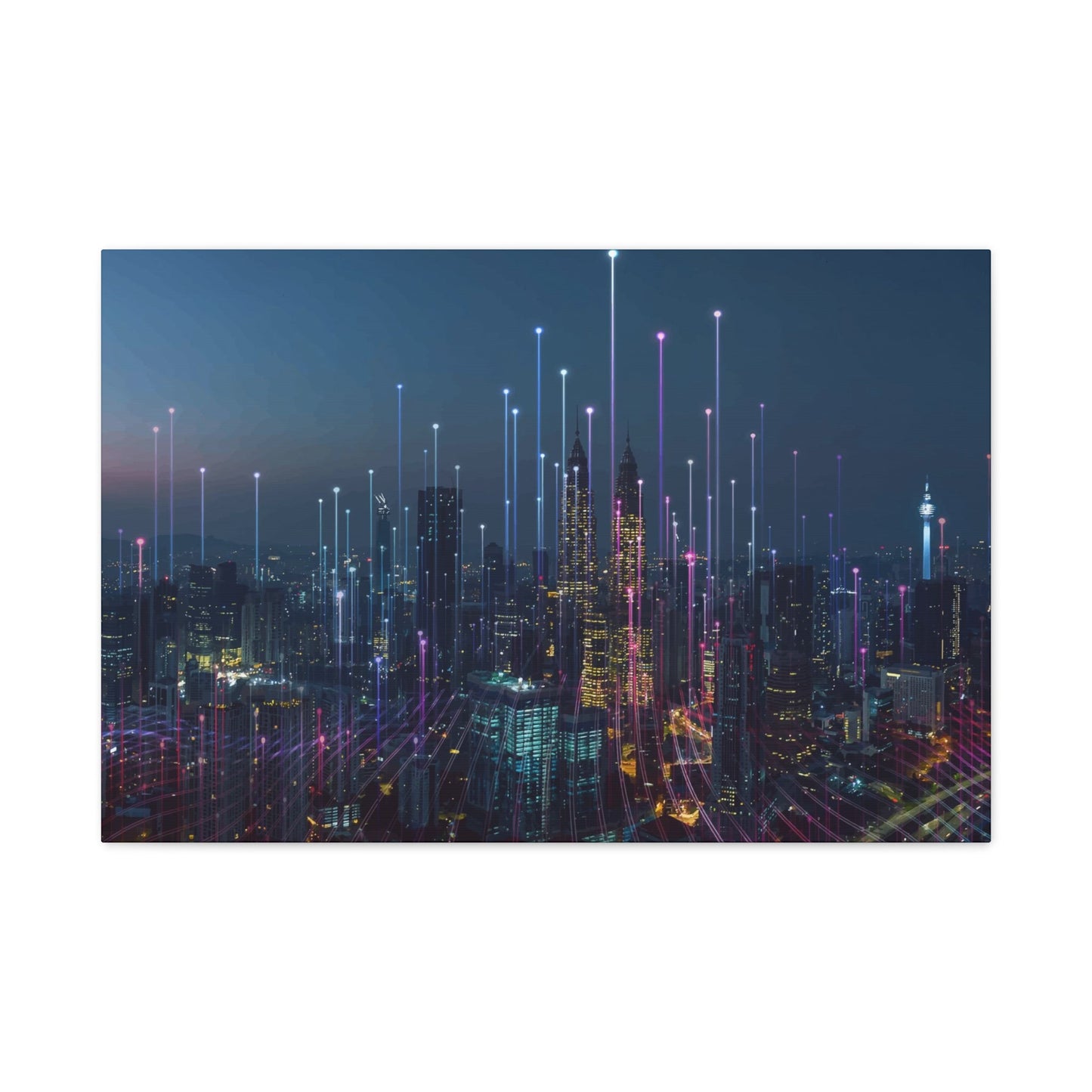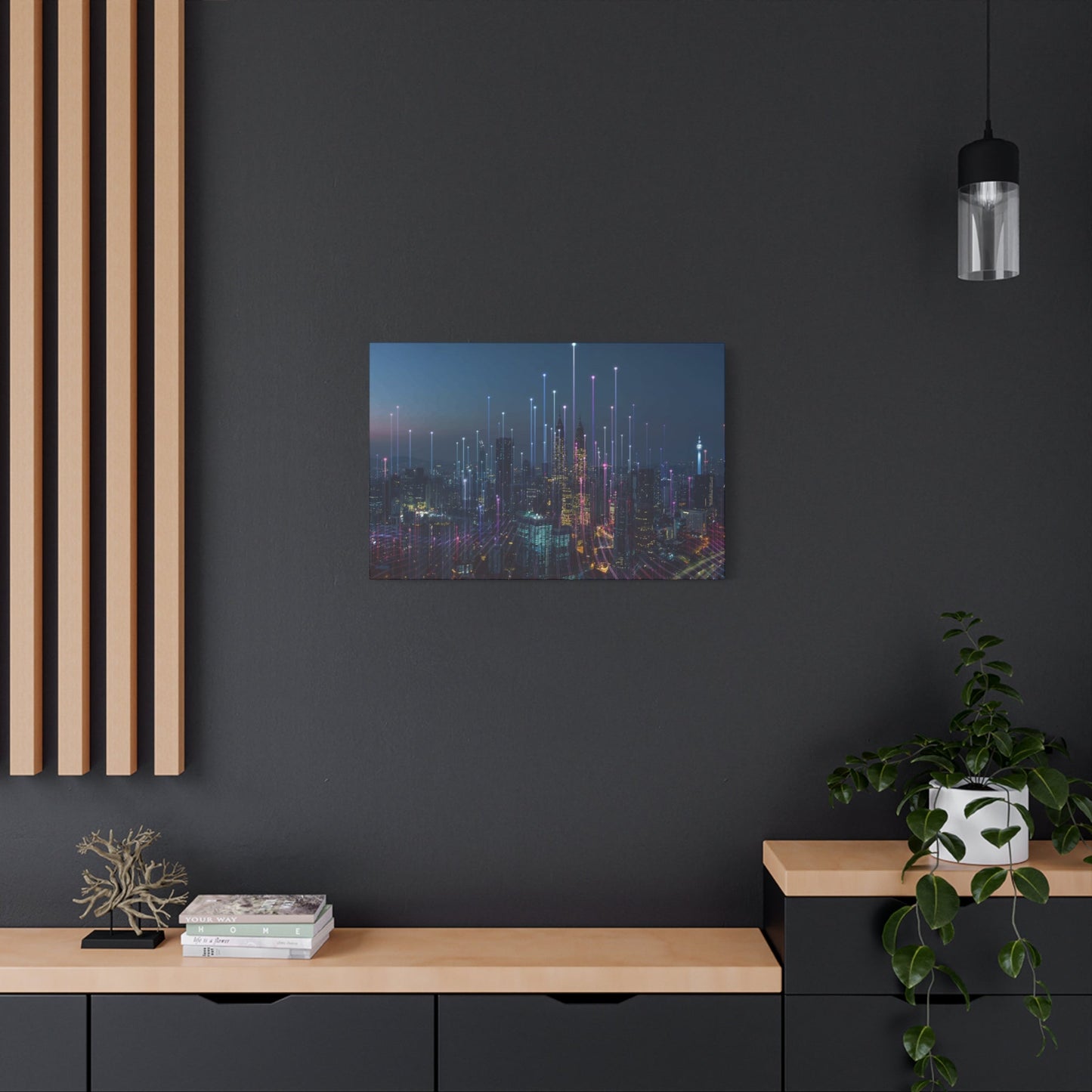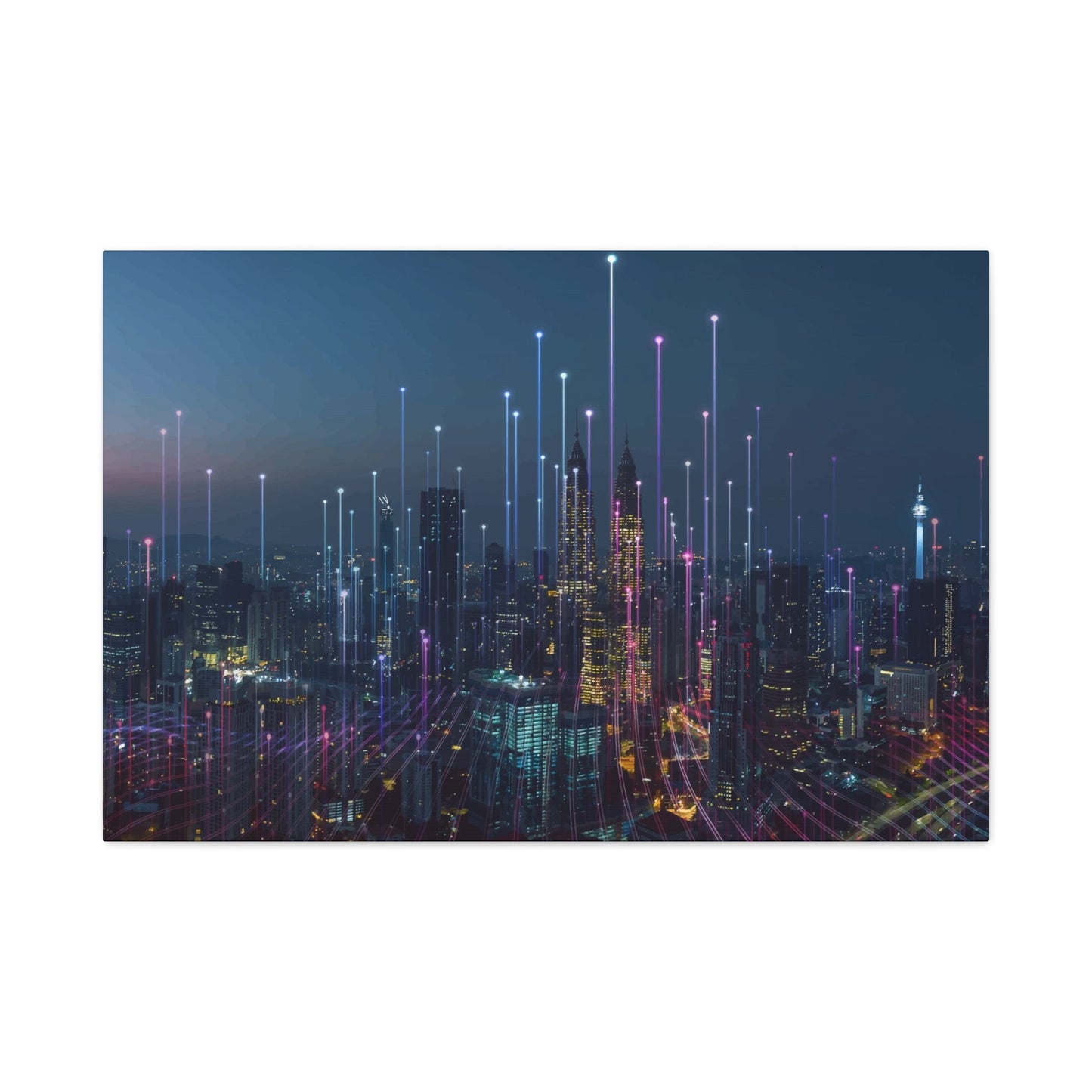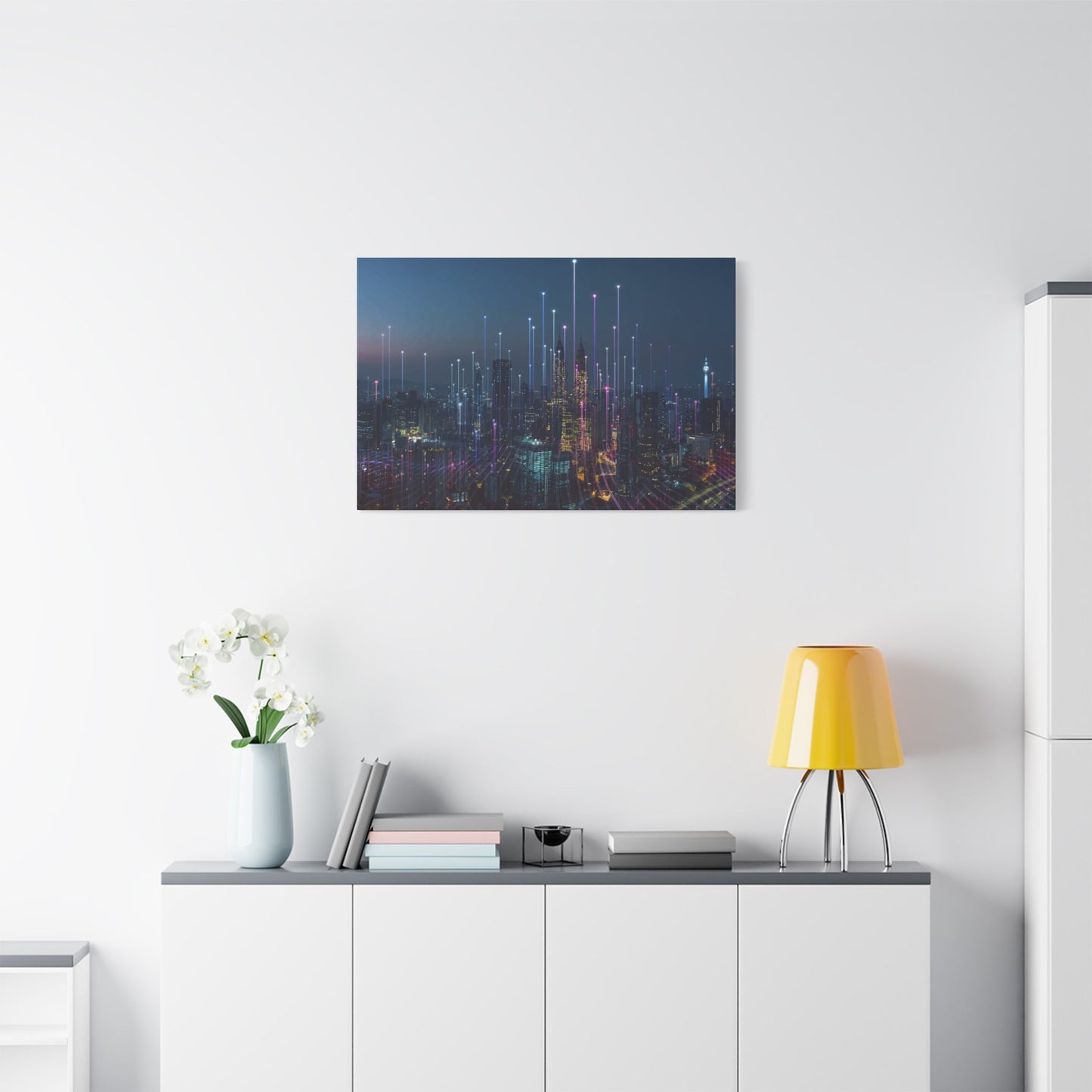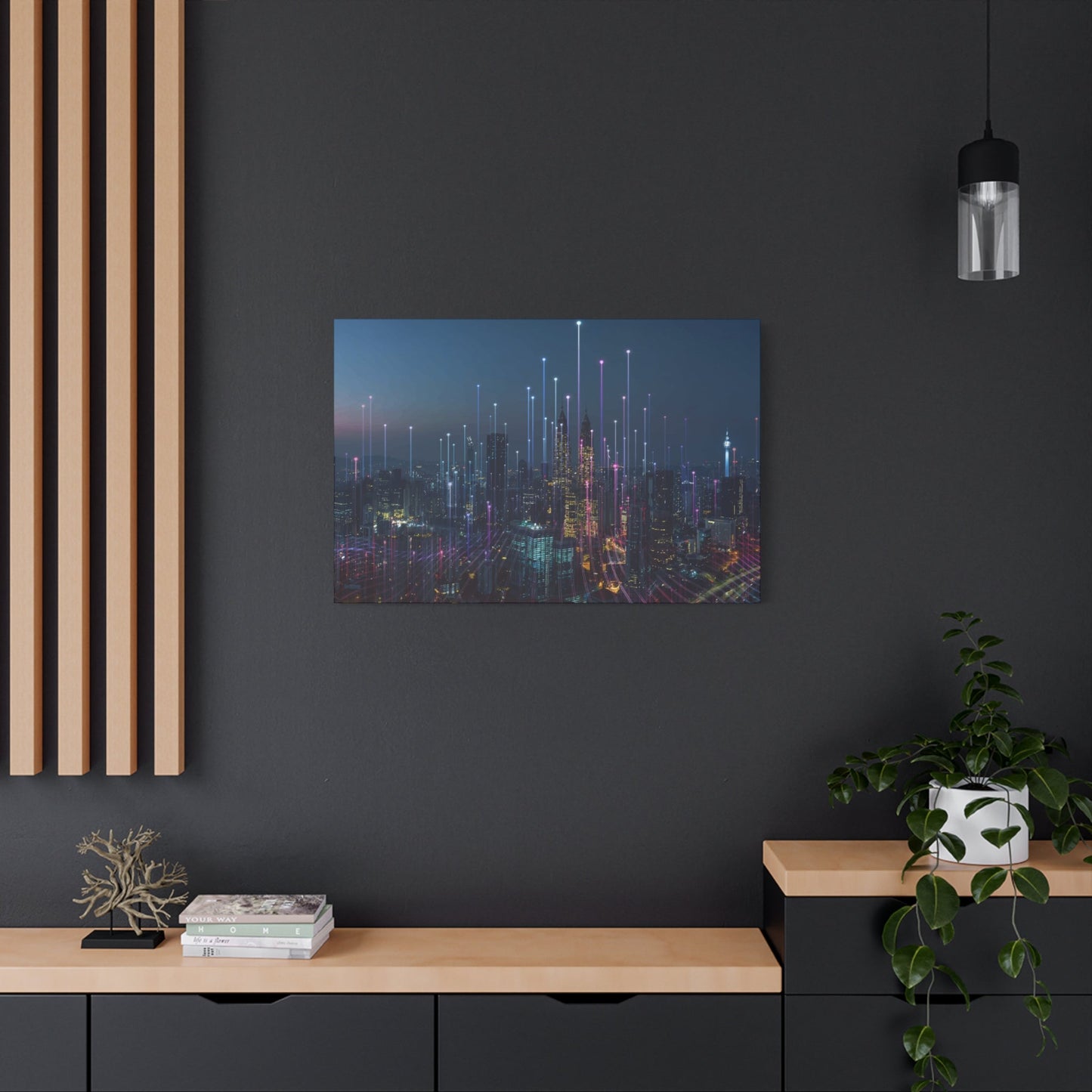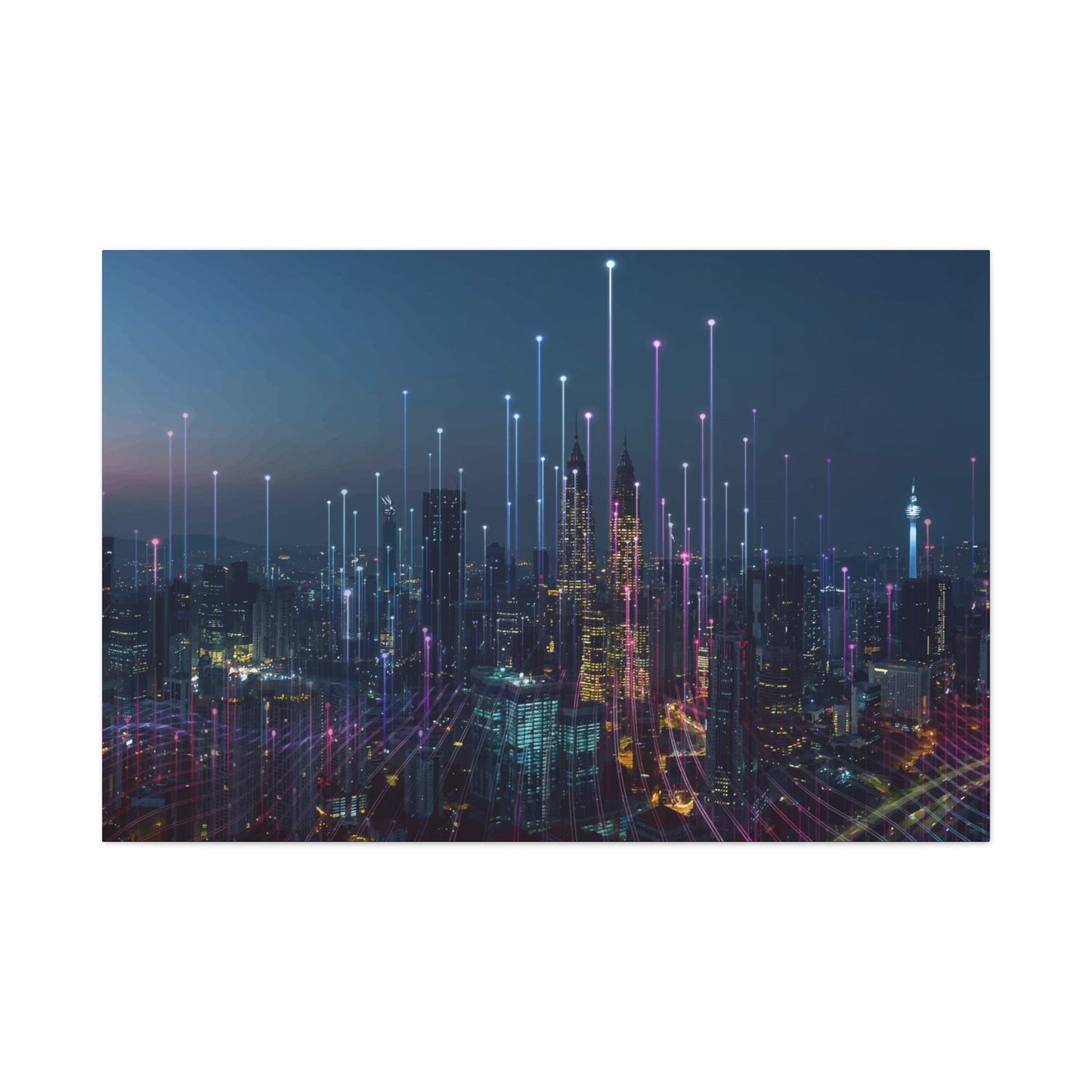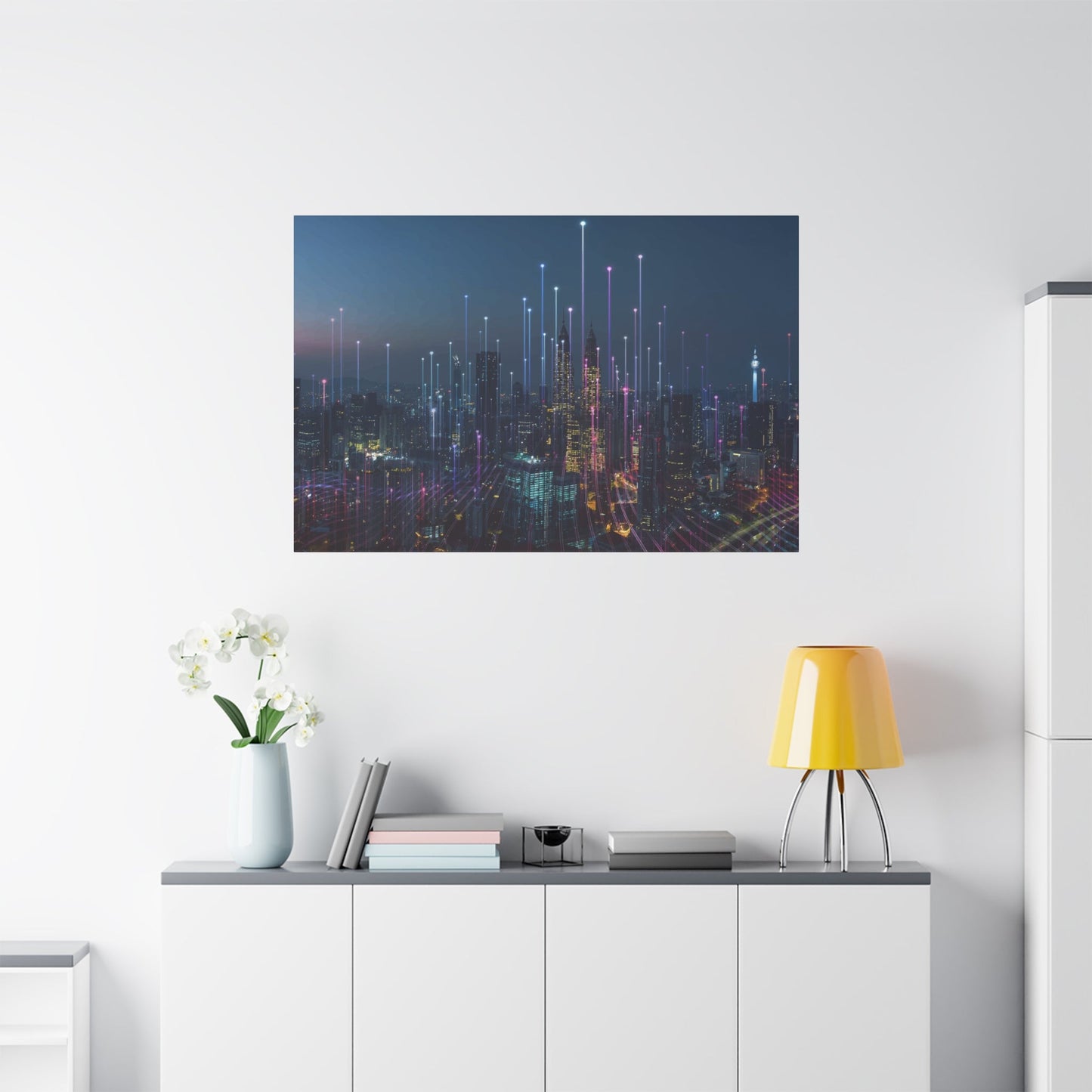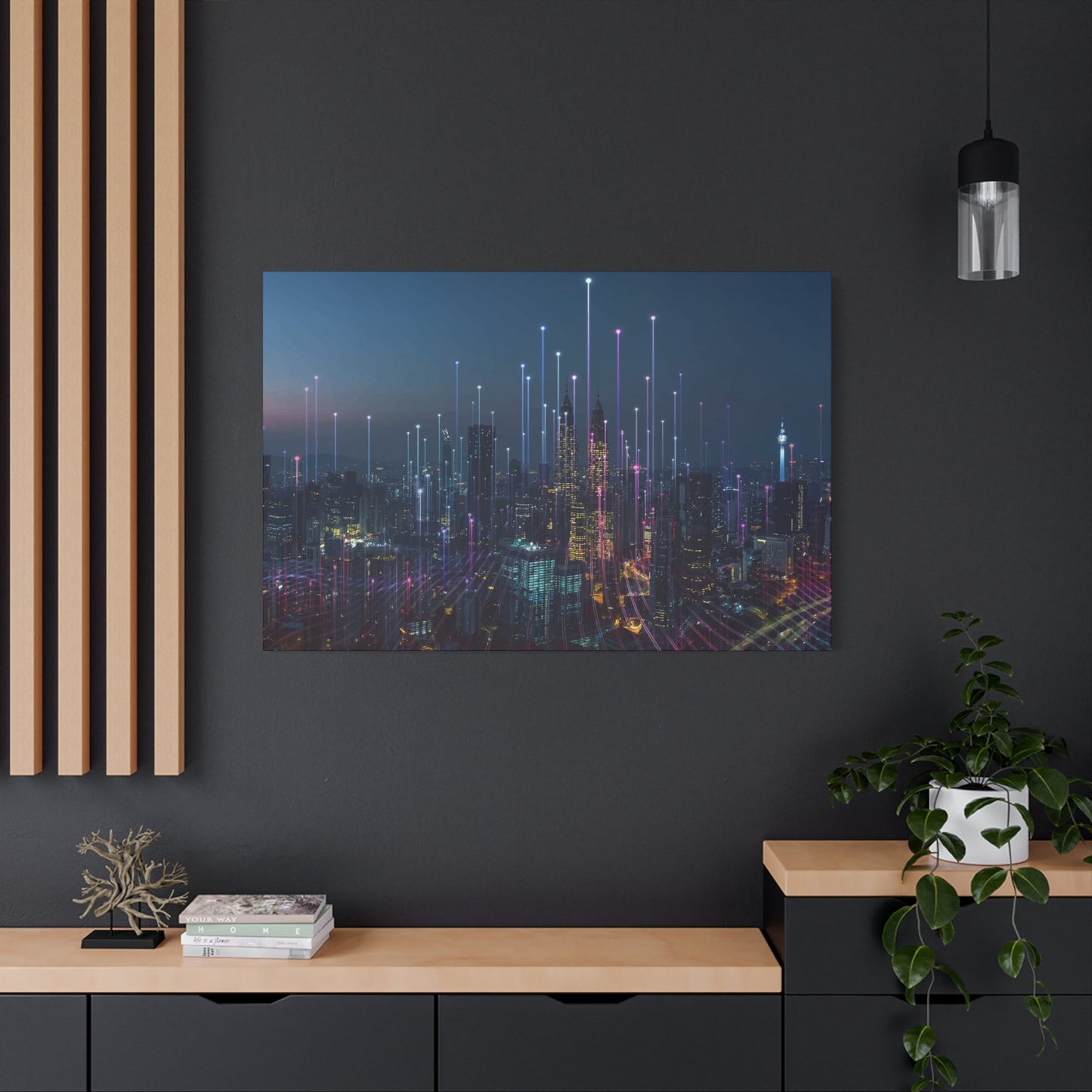Smart City Abstract Wall Art: Envisioning Tomorrow's Urban Aesthetics
In the confluence of rapid urbanization and technological advancement, a new visual language is emerging, one that captures the pulse of our increasingly connected world. This artistic movement, known as smart city abstract wall art, transcends mere decoration. It is a profound reflection of the digital age, a visual symphony of data, infrastructure, and human experience within the modern metropolis. This genre of art does not seek to replicate the city's physical form but to interpret its soul—the invisible networks, the flow of information, the sustainable energy grids, and the complex algorithms that orchestrate urban life. It translates the silent, humming efficiency of a technologically integrated environment into a tangible aesthetic that can adorn our living and working spaces. As our cities become smarter, our art evolves in parallel, offering a window into the intricate beauty of the systems we build. This comprehensive exploration delves into every facet of smart city abstract wall art, from its conceptual origins and thematic inspirations to its creation, application, and future trajectory. It is an examination of how art humanizes technology, making the abstract tangible and the complex beautiful, allowing us to connect with the sophisticated environments we inhabit on a deeper, more emotional level.
Defining the Digital Metropolis on Canvas
At its core, smart city abstract wall art is an artistic interpretation of the systems, data, and philosophies that define a "smart city." Unlike traditional cityscapes that focus on recognizable landmarks and architectural silhouettes, this genre delves into the unseen infrastructure. It visualizes the flow of data packets through fiber-optic networks, the rhythmic pulse of traffic managed by artificial intelligence, the interlocking grids of renewable energy, and the interconnectedness of Internet of Things (IoT) devices. The "abstract" nature is crucial; it liberates the artist from the constraints of literal representation, allowing them to use color, line, shape, and texture to convey concepts like efficiency, connectivity, sustainability, and speed. A piece might feature a series of sharp, glowing lines on a dark background to represent data transmission at night, or a complex geometric pattern of interlocking circles to symbolize the integrated systems of urban management. This art form is not just about aesthetics; it is a narrative. It tells the story of a city that is not just a collection of buildings, but a living, breathing organism of information and technology. It is the visual manifestation of algorithms, the artistic rendering of efficiency, and the colorful expression of a future that is already unfolding around us.
The Philosophical Core of Urban Tech-Art
The philosophical underpinnings of smart city abstract wall art are deeply rooted in the dialogue between humanity and technology. This art form grapples with the questions of our time: How does increasing technological integration affect the human experience? How do we find beauty and meaning in a world driven by data and algorithms? The art serves as a bridge, humanizing the often cold and impersonal nature of technology. By translating data streams into vibrant color palettes and complex network architectures into elegant geometric forms, artists make these concepts approachable and emotionally resonant. There is an inherent optimism in much of this work—a celebration of human ingenuity and our ability to create more efficient, sustainable, and connected urban environments. It reflects a belief in progress and the potential for technology to solve complex societal challenges. However, it can also explore the inherent tensions. Some pieces might evoke a sense of controlled chaos, reflecting the overwhelming nature of constant connectivity, or use stark, minimalist forms to question the potential for alienation within these highly structured systems. Ultimately, this art is a form of contemporary philosophy expressed visually, encouraging viewers to contemplate their place within the evolving digital landscape and to appreciate the intricate, often invisible, beauty of the systems that shape modern life.
The Symbiotic Relationship Between Urban Innovation and Artistic Expression
Throughout history, the city has been a primary muse for artists. The bustling boulevards of Impressionist Paris, the towering skyscrapers of early 20th-century New York, and the gritty streets of post-war Berlin all fueled powerful artistic movements. Smart city abstract wall art is the next evolution in this long and storied relationship. It marks a significant shift in focus from the visible city to the invisible one. The artist’s gaze moves from the architectural facade to the underlying digital framework. This symbiotic relationship works in both directions. Urban innovation provides artists with a rich new vocabulary of concepts to explore: data visualization, network topology, algorithmic patterns, and sensor grids. The very tools used to build and manage smart cities, such as data analysis software and artificial intelligence, are also becoming tools for artistic creation. In return, the art gives the smart city a cultural identity and an aesthetic dimension. It helps residents and policymakers visualize and connect with the abstract concepts that are reshaping their environment. Public installations of this art can transform a sterile tech park into a vibrant cultural hub, while pieces in a corporate boardroom can inspire innovative thinking. Art makes the city's intelligence not just functional but also beautiful and meaningful, fostering a sense of pride and belonging in a technologically advanced community.
Decoding the Visual Language of Urban Futurism
The visual language of smart city abstract wall art is distinct and multifaceted, drawing from a variety of aesthetic traditions while forging its own unique identity. A key element is the use of geometric abstraction. Lines, circuits, and grids are prevalent motifs, representing networks, infrastructure, and the orderly logic of computer systems. These are often rendered with crisp, clean precision, evoking a sense of technological sophistication. Color theory plays a critical role in conveying meaning. Electric blues, vibrant cyans, and neon greens are frequently used to signify data flow, electricity, and digital communication, often set against deep, dark backgrounds to represent the digital space or the city at night. Conversely, palettes incorporating earthy greens, warm yellows, and bright whites might be used to represent sustainability, solar power, and clean energy initiatives. Texture, or the lack thereof, is also a deliberate choice. Smooth, glossy surfaces, such as those found on acrylic or metal prints, enhance the futuristic and sleek feel. In contrast, a piece on textured canvas might introduce a more organic, human element into the technological theme. The overall composition often emphasizes flow, connectivity, and complexity. There is a sense of dynamic movement, of interlocking parts working in concert, mirroring the complex, interconnected systems of a smart city.
Data Streams and Light Trails as Artistic Motifs
Among the most powerful and recurring motifs in smart city abstract wall art are the visual representations of data streams and light trails. These elements capture the essence of the city as a dynamic entity, defined by constant movement and communication. Artists visualize data not as static numbers but as flowing rivers of light, weaving through the urban fabric. These can be depicted as sharp, laser-like lines crisscrossing a canvas, representing the instantaneous transfer of information, or as soft, ethereal glows that seep through geometric structures, symbolizing the ambient presence of wireless networks. Light trails, inspired by long-exposure photography of traffic, are reimagined to represent more than just vehicles. In this context, they can symbolize the movement of people tracked by sensors, the flow of goods in an automated logistics network, or the surge of electricity through the power grid during peak hours. The colors of these trails are often symbolic: red for high traffic or energy usage, green for efficiency and clear pathways. By focusing on these ephemeral, intangible flows, artists highlight a fundamental truth of the smart city: its true lifeblood is not concrete and steel, but the invisible, ceaseless current of information that powers its intelligence.
Architectural Blueprints Reimagined as Abstract Forms
Traditional architectural blueprints are precise, functional documents. In the hands of a smart city abstract artist, they become a source of profound inspiration, deconstructed and reimagined as pure abstract form. The artist is not interested in the blueprint as a guide for construction, but as a repository of geometric beauty and systemic logic. They might isolate the clean lines and right angles of a building's floor plan, transforming them into a minimalist composition that speaks to order and structure. The complex layering of electrical, plumbing, and HVAC systems in a technical drawing can be reinterpreted as an intricate web of overlapping shapes and colors, symbolizing the hidden complexity of modern infrastructure. The very grid lines that organize a blueprint can become the primary subject of the artwork, creating a rhythmic, patterned effect that evokes the structured nature of urban planning. This approach allows the artist to celebrate the intelligence and foresight inherent in design without being tied to a literal depiction of a building. The result is an artwork that feels both structural and cerebral, a tribute to the human capacity for planning and creating complex systems, which is the very foundation upon which the smart city is built. It is an homage to the unseen order that makes urban life possible.
The Influence of Circuit Boards and Microchips
The intricate and mesmerizing design of circuit boards and microchips serves as a direct and potent inspiration for smart city abstract wall art. These technological artifacts are, in essence, miniature cities themselves, with pathways for electricity, hubs for processing, and zones for memory. Artists draw upon this micro-aesthetic to comment on the macro-scale of the urban environment. The fine, metallic lines of conductive traces on a PCB (Printed Circuit Board) are magnified and translated into bold, graphic elements on a canvas. The dense, logical arrangement of components on a microchip is reimagined as a complex, abstract cityscape viewed from above. The use of metallic paints—golds, silvers, and coppers—directly references the materials used in electronics, adding a layer of authenticity and iridescence to the artwork. This visual metaphor is powerful: it suggests that the city itself functions like a massive, integrated circuit. Each building is a component, each road a conductive path, and each data center a processor. By adopting the visual language of microelectronics, the artist creates a powerful connection between the tangible, large-scale city and the microscopic technology that underpins its intelligence, reminding the viewer that the entire urban superstructure is powered by these tiny, brilliant designs.
Algorithmic Patterns and Generative Art
A fascinating sub-genre of smart city abstract wall art is that which is not merely inspired by technology, but is actively created by it. This is the realm of generative art, where the artist designs an algorithm or a set of rules and then allows a computer to generate the final visual output. This process perfectly mirrors the functioning of a smart city, which itself operates on a series of complex algorithms managing everything from traffic flow to energy distribution. The artist becomes a sort of digital urban planner, setting the parameters (the "laws" of the artwork's universe), while the computer executes the plan, often with an element of structured randomness that leads to unique and unpredictable results. The resulting artworks can be mesmerizingly complex, featuring fractal patterns that evoke urban sprawl, or organic, flowing forms that visualize the output of a sensor network over time. This type of art is the most direct possible translation of the smart city's logic into an aesthetic object. It is not just a picture of a system; it is a system that has created a picture. Owning a piece of generative smart city art is like owning a visual artifact of an algorithm, a frozen moment of pure computational creativity.
Sustainability and Green Energy Grids in Art
As sustainability is a cornerstone of the smart city concept, it is also a vital theme in its associated art. Artists are increasingly focused on visualizing the green transition within the urban landscape. This is not about painting literal solar panels or wind turbines, but about capturing the essence of clean energy and ecological balance through abstract means. Artworks might feature circular motifs and radiating lines in warm yellows and oranges to evoke the power of the sun, with these elements seamlessly integrated into a larger urban grid. The concept of a smart grid—an intelligent electricity network that optimizes energy distribution—is represented through intricate, interconnected patterns of glowing green and blue lines, symbolizing the efficient and harmonious flow of power. Themes of water recycling and waste management might be depicted through swirling, cyclical forms and a palette of blues, greens, and earthy browns. This art serves an important cultural function: it makes the often-invisible efforts of sustainability visible and beautiful. It acts as a positive reinforcement of green values, celebrating the integration of nature and technology and envisioning a future where our cities are not just technologically advanced, but also environmentally responsible and in harmony with the natural world.
The Emotional Spectrum of Urban Connectivity
While smart city abstract wall art often celebrates efficiency and logic, it also delves deeply into the emotional spectrum of life within a hyper-connected environment. The art can explore the dichotomy of connectivity: the sense of belonging to a vast, interconnected community versus the potential for digital isolation. A piece might use a web of warm, interconnected lines, all converging on a central, glowing hub, to evoke a feeling of community, shared knowledge, and collective intelligence. The vibrant energy and excitement of a bustling, data-rich city can be captured through chaotic yet harmonious explosions of color and dynamic shapes. Conversely, other artworks may explore the more somber aspects. A composition dominated by stark, rigid grids and isolated points of light could evoke a sense of loneliness or anonymity within a vast, regulated system. The feeling of being constantly monitored or "seen" by the city's sensor network might be translated into patterns resembling eyes or surveillance grids. The color palette can shift dramatically to convey these emotions, from the optimistic brights of a connected utopia to the cool, detached blues and grays of a dystopian vision. This emotional depth is what elevates the genre beyond mere technological illustration, allowing it to resonate with the real, lived experiences of individuals navigating the complexities of modern urban life.
Exploring the Aesthetics of Network Topologies
Network topology, the study of the arrangement of a network's various elements, provides a rich and largely untapped source of aesthetic inspiration for artists. This field, which includes diagrams of bus, ring, star, and mesh networks, is inherently abstract and geometric. Artists translate these technical diagrams into compelling visual compositions. A mesh network, where every node is interconnected, can be transformed into a beautiful and complex web of interwoven lines, symbolizing resilience, decentralization, and community. The orderly, centralized structure of a star network becomes a powerful radial composition, with lines of energy or information flowing to and from a central core. The linear progression of a bus topology can be reinterpreted as a minimalist artwork focusing on a single, powerful line or vector, representing a primary data trunk or transportation corridor. The colors used can add another layer of meaning, with different hues representing different types of data or levels of traffic. By turning these functional schematics into art, the creator celebrates the elegance and ingenuity of network design. It is a form of art that finds beauty in pure structure, revealing the hidden geometric order that enables our digital world to function and our smart cities to communicate.
Minimalism in Depicting Technological Complexity
In a genre defined by the complexity of its subject matter, minimalism emerges as a powerful and sophisticated artistic approach. Instead of attempting to capture the entirety of the smart city's intricate web, minimalist artists focus on distilling its essence into the simplest possible forms. A single, perfectly straight line of vibrant color bisecting a monochromatic canvas could represent a fiber-optic cable, the speed of light, or the concept of a direct connection. A series of precisely arranged dots might symbolize the nodes of a sensor network, their spacing and size conveying information about density and activity. A simple composition of two or three interlocking geometric shapes could represent the synergy between different urban systems, such as transport, energy, and governance. This "less is more" philosophy forces the viewer to engage more deeply with the artwork, to contemplate the vast ideas contained within the simple forms. Minimalist smart city art is confident and intellectual. It strips away all the noise and chaos to reveal the underlying principles of order, efficiency, and purpose that govern the technological metropolis. It is a quiet, contemplative counterpoint to the more dynamic and visually dense pieces in the genre, offering a moment of focused clarity.
The Role of Color Theory in Visualizing Data
Color is not merely decorative in smart city abstract wall art; it is a primary vehicle for conveying information and meaning. Artists employ sophisticated color theory to create a visual shorthand for the complex data sets that define urban life. This practice is closely related to professional data visualization but is freed from the constraints of pure accuracy, allowing for greater emotional and aesthetic expression. For instance, a heat map of urban activity can be transformed into a stunning abstract piece. Instead of a literal map, the artist might create a canvas where fiery reds and oranges bleed into cool blues and purples, representing the shifting pulse of human presence from day to night. The efficiency of a public transit system could be visualized through a network of lines where green indicates on-time performance, yellow signifies minor delays, and red highlights significant disruptions. Financial data flows might be rendered in shades of gold and silver, while environmental data could be represented by a spectrum of greens and browns. This use of color makes the invisible data visible and intuitive. It allows the viewer to understand the state of the city at a glance, not through charts and graphs, but through an immediate, emotional response to the artwork itself.
Kinetic and Interactive Smart City Artworks
The most cutting-edge evolution of this genre moves beyond the static canvas to embrace kinetic and interactive elements, creating artworks that are themselves "smart." These pieces are directly connected to the city's data streams, changing in real-time to reflect the urban environment. Imagine a wall sculpture composed of LED light strips that brighten and dim in response to the city's real-time electricity consumption. Picture a digital canvas where the colors and patterns shift based on live weather data, becoming turbulent before a storm and serene on a clear day. An artwork could be linked to public transit APIs, with lines of light moving across its surface to mirror the actual movement of buses or trains. These interactive pieces are the ultimate expression of the smart city concept. They are not just representations of the city's intelligence; they are active participants in it. They bridge the gap between art and information, creating a living, breathing display that is both aesthetically captivating and contextually aware. For the owner, this type of art offers a unique and dynamic connection to their city, a constantly evolving window into the unseen rhythms that surround them. It transforms the wall from a passive surface into an active interface with the urban ecosystem.
Canvas Prints as a Gateway to Futuristic Decor
For many enthusiasts of smart city aesthetics, the giclée canvas print is the most accessible and versatile medium. This method of high-quality inkjet printing allows for the reproduction of complex digital designs with stunning color accuracy and detail, making it perfect for capturing the vibrant hues and crisp lines characteristic of the genre. A stretched canvas print offers a classic gallery look that seamlessly integrates into a variety of interior design schemes, from minimalist to industrial. The texture of the canvas itself can add a subtle organic warmth to the often cool and technical subject matter, creating a pleasing balance. The absence of a reflective glass covering, common with framed prints, ensures that the artwork can be viewed from any angle without glare, allowing the viewer to fully immerse themselves in the intricate details of the piece. Furthermore, canvas prints are lightweight and relatively affordable, making it possible for a wider audience to begin collecting smart city abstract wall art and to transform their living or work spaces with a touch of futuristic vision. They serve as a perfect entry point, a way to bring the high-concept world of urban data and technological systems into the home in a tangible and aesthetically pleasing format.
The Sleek Allure of Metal and Acrylic Mediums
When the goal is to create an artwork that embodies a truly futuristic and high-tech aesthetic, metal and acrylic prints are the ultimate choice. Printing a smart city abstract design on a sheet of aluminum gives the piece an incredible luminescence and depth. The metallic surface interacts with light, causing the colors, especially the electric blues and vibrant neons, to pop with an almost electric intensity. The sleek, industrial feel of the metal perfectly complements the technological subject matter, creating a cohesive and sophisticated statement piece. Acrylic prints offer a different but equally stunning effect. The image is printed on the back of a polished sheet of acrylic, which is then mounted on the wall. This process creates a remarkable sense of depth; the image appears to float behind a glossy, crystal-clear surface. The colors are rendered with exceptional vibrancy and the details are razor-sharp. Both metal and acrylic are frameless, durable, and have a clean, modern edge that is perfectly suited to contemporary interiors. These mediums transform the artwork from a simple image into a sleek, high-end object, an artifact of the future that feels as advanced and polished as the smart cities it depicts.
Integrating Smart City Art in Residential Spaces
Incorporating smart city abstract wall art into a home is about making a statement about one's connection to the modern world and an appreciation for forward-thinking design. In a living room, a large, dynamic piece can serve as a powerful focal point, sparking conversation and setting a sophisticated, contemporary tone. A composition featuring flowing lines and vibrant colors can add a sense of energy and movement to the space, while a more minimalist, geometric piece can enhance a sense of order and tranquility. In a home office, this type of art is particularly fitting. It can create an inspiring environment that fosters innovation, focus, and creative problem-solving. A piece depicting network topologies or algorithmic patterns can be a constant, subtle reminder of the power of systems thinking and connectivity. Even in more personal spaces like a bedroom, a more serene and minimalist piece with a cool color palette can promote a sense of calm and orderly restfulness. The key is to choose an artwork that not only complements the existing decor but also resonates with the homeowner's personal relationship with technology and the future, turning their home into a personal gallery of the digital age.
Transforming Corporate Environments with Tech-Inspired Art
In corporate settings, particularly within the technology, finance, and urban planning sectors, smart city abstract wall art is more than just decoration; it is a declaration of identity and purpose. In a reception area or lobby, a monumental artwork can make a bold first impression on clients and visitors, immediately communicating that the company is innovative, forward-looking, and deeply engaged with the future. In boardrooms and conference rooms, these pieces can stimulate creative thinking and strategic discussion. An artwork that visualizes complex data systems can inspire new ways of looking at business challenges and opportunities. For employees in open-plan offices, a curated selection of smart city art can help to define different zones, add visual interest to an otherwise monotonous space, and boost morale. It reinforces a shared sense of mission and pride, reminding the team that their work is part of a larger, exciting technological evolution. By surrounding employees with art that reflects the company's core values of innovation, efficiency, and connectivity, businesses can cultivate a more dynamic, inspiring, and intellectually stimulating work environment. The art becomes a part of the corporate culture, a visual testament to the brand's commitment to shaping the future.
Public Art Installations: The City as a Canvas
When smart city abstract art moves out of private homes and offices and into the public realm, it reaches its fullest potential. Large-scale public installations can transform the urban environment itself, turning ordinary spaces into dynamic art experiences. Imagine a mural on the side of a data center, its design an abstract visualization of the information being processed inside. Picture a light sculpture in a public plaza whose patterns are driven by the flow of pedestrians detected by nearby sensors. A series of panels along a subway platform could display generative art that changes with the speed and frequency of the passing trains. These installations serve multiple purposes. They demystify the complex technologies that run the city, making them visible and engaging for the general public. They create unique, memorable landmarks that contribute to the city's cultural identity and brand. They can also be functional, as in the case of a "data fountain" that visualizes air quality or energy consumption, educating citizens in an aesthetically pleasing way. Public art of this nature is the ultimate integration of the smart city and its culture, a continuous dialogue where the city itself becomes both the subject of the art and its canvas.
The Intersection with Science Fiction and Cyberpunk Aesthetics
Smart city abstract wall art shares a significant amount of its DNA with the visual aesthetics of science fiction, particularly the cyberpunk subgenre. Cyberpunk, with its iconic imagery of neon-drenched futuristic cities, towering mega-structures, and visible data streams, has profoundly influenced how we visualize a technologically saturated future. Artists in this genre often borrow from this established visual language: the high contrast between deep shadows and glowing neon lights, the sense of immense scale and density, and the fusion of organic and synthetic forms. The color palettes—dominated by electric blues, magenta, and acid green—are a direct homage to classic cyberpunk films and literature. However, while cyberpunk often carries a dystopian, cautionary undertone, smart city abstract art frequently reinterprets these aesthetics with a more optimistic or neutral perspective. It takes the "high-tech, low-life" grit of cyberpunk and refines it, focusing more on the elegance of the systems and the potential for a utopian, rather than dystopian, outcome. The art exists in a fascinating dialogue with these fictional worlds, acknowledging their influence while carving out its own unique space, one that is less about cautionary tales and more about celebrating the actual, emerging reality of our technologically integrated urban centers.
The Artist's Role as a Digital Cartographer
In the context of smart city abstract wall art, the artist takes on a new and fascinating role: that of a digital cartographer. Traditional cartographers map physical terrain—mountains, rivers, and coastlines. The digital cartographer, however, maps the invisible landscapes of the 21st century. Their charts do not depict landmasses, but data-masses. Their rivers are not water, but streams of information. Their coastlines are the boundaries between different networks. Using color, shape, and line as their cartographic tools, these artists create maps of concepts. A piece might map the flow of financial transactions across a city in a single day, the topography of wireless signal strength in a neighborhood, or the social network connections of a community. These maps are not meant for navigation in the literal sense; you cannot use them to find a street. Instead, they are for conceptual navigation. They help us to orient ourselves within the complex, abstract systems that govern our lives. They provide a "you are here" sign for the digital world, revealing the hidden structures and patterns in the data that surrounds us. This artistic cartography is essential for understanding our new territory, making the intangible tangible and the invisible visible.
Choosing the Right Piece for Your Interior Design
Selecting the perfect piece of smart city abstract wall art requires a thoughtful consideration of both the artwork and the space it will inhabit. First, consider the scale. A large, open wall in a modern living room or a corporate lobby can handle a monumental statement piece, while a smaller, more intimate space like a home office or a hallway might be better suited to a smaller work or a series of related pieces (a diptych or triptych). The color palette of the artwork should complement the existing decor. You can either choose a piece with colors that harmonize with your current furniture and wall colors for a cohesive look, or select a piece with a bold, contrasting color to act as a dramatic accent. Think about the mood you want to create. An artwork with dynamic, energetic lines and vibrant colors will create a feeling of excitement and innovation. A piece with a more minimalist composition and a serene, monochromatic palette will foster a sense of calm, order, and focus. Finally, consider the artwork's conceptual weight. Do you want a piece that is a direct, recognizable representation of a circuit board, or something more subtly abstract that merely hints at technological themes? The right choice will not only enhance your decor but will also resonate with your personal aesthetic and intellectual sensibilities.
Geometric and Algorithmic Shapes
The shapes and patterns prevalent in smart city abstract wall art have a profound psychological impact on the viewer. Our brains are hardwired to find meaning in patterns, and the geometric and algorithmic forms in this art tap directly into this cognitive process. Geometric shapes like squares and rectangles, with their straight lines and right angles, often convey a sense of stability, order, reliability, and structure. They can make a space feel more grounded and organized, reflecting the logical underpinning of urban systems. Circles and curves, on the other hand, tend to evoke feelings of continuity, harmony, community, and movement. They can represent the cyclical nature of energy, the flow of traffic, or the interconnectedness of a social network. More complex, fractal-like patterns, often found in generative art, can be mesmerizing and intellectually stimulating. They suggest infinite complexity and self-similarity at different scales, mirroring the way a small neighborhood's patterns can reflect the structure of the entire city. The conscious use of these shapes allows the artwork to communicate not just on a visual level, but on a subconscious, psychological one, influencing the mood and energy of the space it occupies and reinforcing the conceptual themes of the smart city.
Creating a Focal Point with High-Tech Imagery
One of the most effective uses of smart city abstract wall art is to create a compelling focal point within a room. A focal point is the area to which the eye is naturally drawn upon entering a space, and it serves as the anchor for the entire interior design scheme. An artwork from this genre is uniquely suited for this role due to its dynamic nature, vibrant colors, and intellectually engaging subject matter. To create a successful focal point, the artwork should be placed in a prominent position, such as above a sofa in the living room, over the headboard in a bedroom, or on the main wall of a dining area. The piece should be of a significant size relative to the wall and the furniture around it—a small picture on a large wall will be lost, while an oversized piece can overwhelm a room. Proper lighting is also crucial. A spotlight or a picture light directed at the artwork will enhance its colors and details, ensuring it commands attention and stands out as the centerpiece of the room. By carefully selecting and positioning a powerful piece of smart city art, you can instantly elevate the sophistication of your space and create a dynamic centerpiece that is both visually stunning and intellectually resonant.
The Future of Art in an AI-Driven World
The rise of artificial intelligence, particularly AI image generators, is poised to revolutionize the creation of smart city abstract wall art. These tools allow artists and even non-artists to generate incredibly complex and polished artworks simply by providing a textual description. An artist could prompt an AI with "An abstract visualization of traffic data in Tokyo during rush hour, in the style of a glowing circuit board with neon blue and red light trails," and receive multiple unique interpretations in seconds. This technology democratizes the creation process and opens up new avenues for artistic exploration. Artists can use AI as a collaborator, a tool for rapid brainstorming and visualization. They can generate a base image with AI and then refine it with their own digital or physical painting techniques, creating a hybrid piece that blends human and machine creativity. This also raises fascinating questions about authorship and originality. Is the artist the one who writes the prompt, or is the AI the artist? As these technologies become more sophisticated, we can expect to see a new wave of smart city art that is even more intricate, data-driven, and conceptually ambitious, pushing the boundaries of what we consider to be art and who we consider to be an artist in an increasingly automated world.
Commissioning a Bespoke Piece of Data Art
For the ultimate personal statement, commissioning a bespoke piece of smart city abstract wall art offers a unique opportunity to create something truly one-of-a-kind. This process allows you to collaborate directly with an artist to translate a specific concept or even a personal data set into a work of art. Imagine a piece that visualizes the data from your own smart home over a month—the ebb and flow of electricity usage, the patterns of your daily routine. You could commission an artwork based on the network traffic of your company, creating a visual signature of your organization's digital life. An engaged couple with a love for technology might commission a diptych that visualizes their digital communication patterns leading up to their wedding. The process typically involves a detailed consultation with the artist to discuss the concept, data sources (if any), desired aesthetic, color palette, and medium. The artist will then develop initial sketches or digital mockups for approval before creating the final piece. The result is more than just a decoration; it is a deeply personal artifact, a story told in the language of data and abstraction, a unique piece of your own smart world made tangible and beautiful.
Preserving and Caring for Your Digital-Age Art
Proper care and preservation are essential to ensure that your investment in smart city abstract wall art remains a vibrant and cherished part of your decor for years to come. The specific care instructions will depend on the medium. For canvas prints, the primary concerns are dust and UV light. They should be dusted regularly with a soft, dry cloth. Avoid using any chemical cleaners. To prevent fading, the artwork should be hung away from direct, prolonged sunlight. If the artwork is in a room with a lot of natural light, consider adding a UV-protective varnish or framing it behind UV-filtering glass. Metal and acrylic prints are generally more durable and easier to clean. They can be wiped down with a soft microfiber cloth, and if necessary, a small amount of mild glass cleaner can be used on acrylic surfaces (always check the manufacturer's recommendations first). For all types of art, it is important to avoid hanging them in areas of high humidity, such as bathrooms, as moisture can damage the materials over time. By taking these simple preventative measures, you can protect the integrity and vibrancy of your artwork, ensuring that its futuristic vision continues to inspire and captivate for a lifetime.
The Marketplace for Smart City Themed Artwork
The marketplace for smart city abstract wall art is a vibrant and growing ecosystem, catering to a wide range of tastes and budgets. It spans from mass-market online retailers offering affordable canvas prints of popular designs to high-end galleries representing established generative artists. Large online art platforms and print-on-demand services provide a vast selection, allowing consumers to browse thousands of options from artists around the world. These platforms often allow for customization in terms of size and medium (canvas, metal, acrylic, framed print). For those seeking more unique or limited-edition pieces, curated online galleries and artist collectives are an excellent resource. These sites often feature interviews with the artists, providing deeper insight into their process and a more personal connection to the work. Social media platforms, especially Instagram and Pinterest, have also become crucial discovery tools, with artists showcasing their latest creations and processes directly to a global audience. Finally, for serious collectors, art fairs specializing in digital and media art, as well as established contemporary art galleries, are beginning to feature artists working in this genre, signaling its growing acceptance and importance within the mainstream art world.
The Role of Augmented Reality in Enhancing Wall Art
Augmented Reality (AR) is set to add an exciting new layer of interactivity to smart city abstract wall art. Imagine pointing your smartphone or tablet at a static canvas print, and through your screen, seeing the artwork come to life. The static lines representing data flows could begin to move and pulse. The geometric shapes representing urban districts could display pop-up information about real-time activity in those areas. An artist could embed a "making-of" video within the artwork, or an audio commentary explaining their conceptual process, all accessible through an AR app. This technology bridges the gap between the physical and digital worlds, transforming a static art object into a dynamic, multi-layered experience. It adds immense value to the artwork, providing context, motion, and a deeper narrative without altering the physical piece itself. For artists, it offers a powerful new tool for expression. For collectors, it provides a novel and engaging way to interact with their art. As AR technology becomes more widespread, we can expect to see more "AR-enabled" wall art, creating a richer, more immersive way to appreciate the fusion of art and technology that defines the smart city aesthetic.
Smart Cities, Smarter Decor
The concept of intelligent urban planning has revolutionized not just how cities function but also how we conceptualize and represent them artistically. The integration of sensors, data networks, and responsive infrastructure that defines modern metropolitan areas provides endless inspiration for artistic interpretation. Translating these concepts into visual form creates decoration that speaks to the interconnected nature of contemporary life and the sophisticated systems that support our daily routines.
Artistic representations inspired by smart infrastructure often incorporate visual metaphors that reference connectivity, data flow, and system integration. Circuit board patterns, network diagrams abstracted into decorative elements, and representations of information exchange become aesthetic choices that carry deeper meaning. These visual references create spaces that feel intellectually engaging, prompting viewers to consider the invisible technological frameworks that enable modern convenience and efficiency.
The color palettes associated with this aesthetic typically draw from the visual language of technology itself. Electric blues reminiscent of digital displays, vibrant greens echoing data streams, and warm amber tones suggesting connectivity create atmospheres that feel both energizing and sophisticated. These colors work particularly well in spaces designed for productivity and creativity, such as home offices, collaborative workspaces, and innovation-focused environments. The psychological impact of these hues has been well-documented, with studies indicating their ability to promote focus, stimulate creative thinking, and maintain engagement over extended periods.
Scale and proportion become important considerations when incorporating these elements into interior spaces. Oversized pieces can create dramatic focal points that anchor entire rooms, while collections of smaller works allow for more nuanced storytelling and visual complexity. The relationship between individual elements within a composition often mirrors the interconnected nature of urban systems themselves, with each component contributing to a larger, more meaningful whole. This creates opportunities for layered interpretation, where viewers discover new details and connections with repeated exposure.
Material selection for pieces within this category has expanded dramatically with advances in manufacturing and artistic technique. Acrylic panels offer sleek, modern surfaces that enhance color vibrancy and create subtle dimensional effects through their transparency and reflective properties. Metal prints provide industrial authenticity that connects directly with the technological themes being explored. Canvas remains popular for its traditional artistic associations while still effectively conveying contemporary imagery. Each material choice contributes distinct characteristics to the final piece, influencing how it integrates with surrounding architectural elements and existing decor.
Conclusion:
The emergence of smart city abstract wall art marks a pivotal moment in the history of both urban-inspired art and interior design. It is more than a fleeting trend; it is a developing visual philosophy that captures the very essence of the 21st-century human experience. This art form stands at the crossroads of immense data, sophisticated technology, and profound human creativity, offering a unique lens through which we can perceive and appreciate the complex, invisible systems that orchestrate modern life. It translates the silent, binary language of our cities—the data streams, the algorithmic decisions, the energy grids, the sensor networks—into a universal language of color, form, and emotion. By doing so, it accomplishes the timeless goal of all great art: it makes the abstract tangible and the unfamiliar relatable.
Throughout this extensive exploration, we have journeyed from the foundational concepts that define this genre to the specific motifs and techniques artists employ. We have seen how the clean logic of architectural blueprints and the intricate beauty of microchips are deconstructed and reimagined as compelling abstract compositions. We have explored how artists use color theory not just for aesthetic appeal, but as a sophisticated tool for visualizing data and conveying meaning. The evolution of the art from static canvas prints to dynamic, interactive installations powered by real-time data and augmented reality highlights its intrinsic connection to the very technology it seeks to represent. This art is not static; it is alive, evolving in lockstep with the cities that inspire it.
Furthermore, we have recognized the profound impact of this art on the spaces we inhabit. In our homes, it serves as a statement of our engagement with the future, a focal point that sparks conversation and inspires innovative thinking. In corporate environments, it transcends mere decoration to become a powerful symbol of a company's identity, values, and forward-looking vision. As public art, it has the power to educate, to beautify, and to foster a deeper connection between citizens and their increasingly intelligent urban environment. This art does not simply hang on a wall; it actively shapes the atmosphere, psychology, and intellectual climate of the space it occupies. It is both a mirror reflecting our technological reality and a window offering a glimpse into the possibilities of the future. As we continue to build and inhabit smarter, more connected cities, the need for this artistic translation will only grow, solidifying smart city abstract wall art as the definitive aesthetic chronicle of our digital age.













